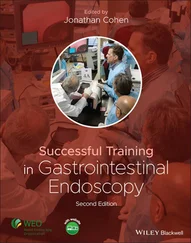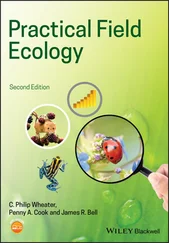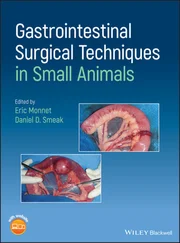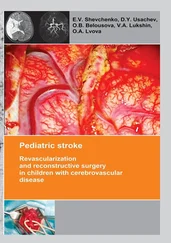1 ...8 9 10 12 13 14 ...26 In parallel with the advances in equipment, we have seen an enormous upskilling of the operators mainly due to the focus on training – this has been made possible by the greater availability of virtual models, hands‐on animal training and more investment in one‐to‐one fellowships and short focused therapeutic endoscopic courses over the last 10–20 years. Online portfolios and direct observer procedure skill assessments are the cornerstones of these advances. Virtually every large GI meeting now has a hands‐on endoscopy component and often a live endoscopy segment as well.
Virtually every year, a new endoscopic application is developed and many of the recent advances are included in this textbook – such as the over‐the‐scope clip for perforation closure, Hemospray® for diffuse GI bleeding, Stretta radioablation of the distal esophagus for reflux treatment, and then the concept of natural orifice transendoluminal surgery (NOTES) needs a mention as the newest kid on the block. This latter exciting technology is in some ways a modality looking for an appropriate application, especially in children, and is discussed at the end of the book.
We have tried to make this text the definitive one for pediatric endoscopy and we hope you enjoy reading it. No doubt more advances in technology will have been developed by the time this book hits the shelves but this is to be applauded. If the velocity of advances continues at the present pace, there is no barrier or horizon that is safe from endoscopy. It is reasonable to say that the gastrointestinal endoscopist should have the aim to make the GI pediatric surgeon virtually redundant. However, it has to be said that increasingly, the two disciplines are working more closely together and pediatric surgeons use endoscopy more and more themselves.
We hope that this book will enthuse the younger generation of trainees to follow the path of minimally invasive solutions to every problem that the GI tract produces in children. We may learn a lot from our adult colleagues but conversely, with our exposure to congenital abnormalities, we may be able to take a lead in these areas also. Imagination is our only barrier.
We would like to thank our colleagues who have kindly given up their valuable time to contribute some really fantastic chapters and images. We hope you really enjoy reading the book and that you gain a lot from it. The images and videos and webpage will allow knowledge to be disseminated widely. Most, if not all, of the world experts in pediatric endoscopy have contributed and we are truly grateful. We would like to thank the publishers, without whose guidance and help this would have been impossible.
This journey would not have been possible without the love and support of our families.
Mike :
thanks to Kay, my wife, and Ella, Jess and Flo, my wondrous daughters who put up with their old dad – especially editing the chapters when on holiday!
George :
many thanks to Irina, my beloved wife and muse, and my two precious artists: my daughter Zhenya and granddaughter Nikka who continue to bring beauty to the world.
Thank you and hopefully those of you who are training now will be contributors in future editions and we will pass on the baton to you in due course. Remember – do no harm and have fun. It is the best specialty you can imagine.
Mike and George
2 History of pediatric gastrointestinal endoscopy
Samy Cadranel, Jean‐François Mougenot, and Douglas S. Fishman
 KEY POINTS
KEY POINTS
Rigid endoscopy as the proof of concept: invisible could be visible: the first step toward exploration of the esophagus and the proximal stomach.
Semiflexible endoscopy as the next step toward correct diagnosis of gastric pathology beyond the gastric body and development of endoscopic target biopsy.
Fiberoptic flexible gastrointestinal endoscopy as the foundation of modern diagnostic and therapeutic pediatric gastrointestinal endoscopy – more recently, videochip at the tip.
During the last half century, two achievements can be considered as major advances in the field of gastroenterology: the adaptation of fiberoptics to gastrointestinal endoscopy, and, as a consequence, the discovery of Helicobacter pylori [1,2]. Indeed, the role of H. pylori would not have been suspected without the pathologic and microbiologic study of biopsy material obtained with the endoscope. Attempts to inspect in vivo the internal cavities of the human body are probably as ancient as medicine itself. The challenge was to find a safe source of light that would not generate heat that could damage tissues.
As early as the end of the 18th century, the Lichtleier, an ancestor of the modern proctoscope, paved the way with a system of lenses illuminated by candlelight. The name “endoscope” was coined as early as 1853 by A.J. Desormeaux for an instrument used in urology [3] while the first “gastroscope” was developed in Erlangen by A. Kussmaul [4]. These instruments were hampered by the fact that they could not direct enough light to the targeted site. With the invention of the electric bulb, a better insight became possible, but these instruments could not be used for prolonged periods of time because of the heat generated by the light bulb.
In 1881, Mikulicz performed the first gastroscopy in a human being using a rigid instrument of 65 cm long and 14 mm diameter [5]. This angulated instrument compensated for the anatomical angulations of the human esophagus and was equipped with a water circulation system to cool the light bulb and channels for the light source and to introduce air.
In 1932, the first semiflexible gastroscope was developed by instrument maker and technician George Wolf and gastroenterologist Rudolf Schindler who is widely rated as “the father of gastroscopy.” This instrument allowed a greater range for examination, facilitating diagnosis and endoscopic treatments.
We cannot leave the discussion of semiflexible gastroscopy without mentioning one of the most decorated American gastroenterologists, Walter L. Palmer, who brought a new level of understanding to the diagnosis and treatment of digestive diseases, particularly peptic ulcer, gastrointestinal cancer, and ulcerative colitis. In 1934, he facilitated the release of Dr. Schindler from a Nazi concentration camp where he was held because of his part‐Jewish blood. Eventually, Dr Schindler immigrated to the US. In 1941 he founded the Gastroscopic Club, now the American Society for Gastrointestinal Endoscopy, and became its first president.
The development of fiberoptics led to the birth of modern gastrointestinal endoscopy.
In the hybrid semiflexible gastroscope built by the German instrument maker Storz in 1966, lenses were used for visualization while the electric light bulb was replaced by optical fibers made of either glass or plastic. Plastic fibers were more flexible and durable than glass; however, glass optical fibers could be manufactured with diameters smaller than their plastic counterparts, and the quality of light transmission was superior in glass optical fibers. The next improvements in fiberoptic technology were due to optical engineers who considered the possibility of fiberoptics transmitting not only light but also images. In 1954, two articles were published in the same issue of Nature , a brief note by van Heel on the “transport of images” and an extensive article on a flexible fiberscope by Harold Hopkins of London and his co‐worker Narinder Singh Kapany [6]. Thanks to the collaboration between Basil Hirschowitz and the physicist Larry Curtiss who succeeded (with the aid of Corning Glass) in producing high‐quality fiberoptics, clinical application of fiberoptics to gastrointestinal endoscopy became possible and was reported in Gastroenterology in 1958 [7].
Читать дальше
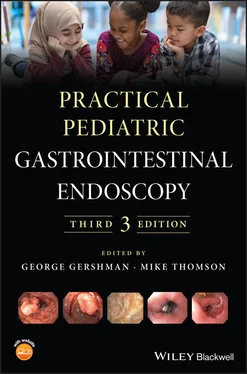
 KEY POINTS
KEY POINTS
